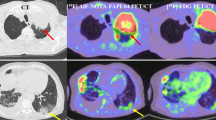Abstract
A dedicated chest computed radiography (CR) system has an option of energy subtraction (ES) acquisition. Two imaging plates, rather than one, are separated by a copper filter to give a high-energy and low-energy image. This study compares the diagnostic accuracy of conventional computed radiography to that of ES obtained with two radiographic techniques. One soft tissue only image was obtained at the conventional CR technique (s=254) and the second was obtained at twice the radiation exposure (s=131) to reduce noise. An anthropomorphic phantom with superimposed low-contrast lung nodules was imaged 53 times for each radiographic technique. Fifteen images had no nodules; 38 images had a total of 90 nodules placed on the phantom. Three chest radiologists read the three sets of images in a receiver operating characteristic (ROC) study. Significant differences in Az were only found between (1) the higher exposure energy subtracted images and the conventional dose energy subtracted images (P=.095, 90% confidence), and (2) the conventional CR and the energy subtracted image obtained at the same technique (P=.024, 98% confidence). As a result of this study, energy subtracted images cannot be substituted for conventional CR images when detecting low-contrast nodules, even when twice the exposure is used to obtain them.
Similar content being viewed by others
References
MacMahon H: Digital chest radiography at the University of Chicago: Present status and future plans. J Digit Imaging 8:11–14, 1995
Freedman M, Stellar P, Jafroudi H, et al: Quality control of storage phosphor digital radiography systems. J Digit Imaging 8:67–74, 1995
Chotas HG, Floyd CE, Raven CE: Technical evaluation of a digital chest radiography system that uses a selenium detector. Radiology 195:264–270, 1995
Brody WR, Butt G, Hall A, et al: A method for selective tissue and bone visualization using dual energy scanned projection radiography. Med Phys 8:353–357, 1981
Ishigaki T, Sakuma S, Ikeda M: One-shot dual-energy subtraction chest imaging with computed radiography: Clinical evaluation of film images. Radiology 168:67–72, 1988
Stewart BK, Huang HK: Single-exposure dual-energy computed radiography. Med Phys 17:866–875, 1990
Kimme-Smith C, Aberle DR, Sayre JW, et al: Effect of reduced exposure on computed radiography: Comparison of nodule detection accuracy with conventional and asymmetric screen-film radiographs of a chest phantom. AJR Am J Roentgenol 165:269–273, 1995
Kimme-Smith C, Hart E, Goldin J, et al: Detection of simulated lung nodules with computed radiography: Effects of nodule size, local optical density, global object thickness, and exposure. Acad Radiol 3:735–741, 1996
Fuji Photo Film Co. Ltd: Fuji Computed Radiography Technical Review for FCR 9501 ES/FCR DX-A, 1996
Kundel HL, Revesz G: Lesion conspicuity structured noise and film reader error. AJR Am J Roentgenol 126:1233–1238, 1976
Metz CE: Some practical issues of experimental design and data analysis in radiological ROC studies. Invest Radiol 24:234–245, 1988
Dorfman DD, Alf E: Maximum likelihood estimation of parameters of signal detection theory and determination of confidence intervals: Rating method data. J Math Psychology 6:487–496, 1969
Dorfman DD, Berbaum KS, Metz CE: Receiver operating characteristic rating analysis: Generalization to the population of readers and patients with the jackknife method. Invest Radiol 27:723–731, 1992
Niklason LT, Chan HP, Cascade PN, et al: Portable chest imaging: Comparison of storage phosphor digital, asymmetric screen-film, and conventional screen film systems. Radiology 186:387–393, 1993
Dobbins JT, Rice JJ, Beam CA, et al: Threshold perception performance with computed and screen-film radiography: Implications for chest radiography. Radiology 183:179–187, 1992
Leppert AGA, Prokup M, Schaefer-Prokop CM, et al: Detection of simulated chest lesions: comparison of a conventional screen-film combination, an asymmetric screen-film system and storage phosphor radiology. Radiology 195:259–263, 1995
Alvarez RE, Siebert JA, Poage TF: Active dual energy x-ray detector: Experimental characterization. SPIE Med Imag 3032:419–426, 1997
Hendee WR, Kelsey CA, Cohen G: Point/counterpoint: Medical technologies should pass performance and cost-effectiveness review in centers of excellence before being released for diffusion in the clinical community. Med Phys 25:1099–1101, 1998
Author information
Authors and Affiliations
Rights and permissions
About this article
Cite this article
Kimme-Smith, C., Davis, D.L., McNitt-Gray, M. et al. Computed radiography dual energy subtraction: Performance evaluation when detecting low-contrast lung nodules in an anthropomorphic phantom. J Digit Imaging 12, 29–33 (1999). https://doi.org/10.1007/BF03168624
Issue Date:
DOI: https://doi.org/10.1007/BF03168624




